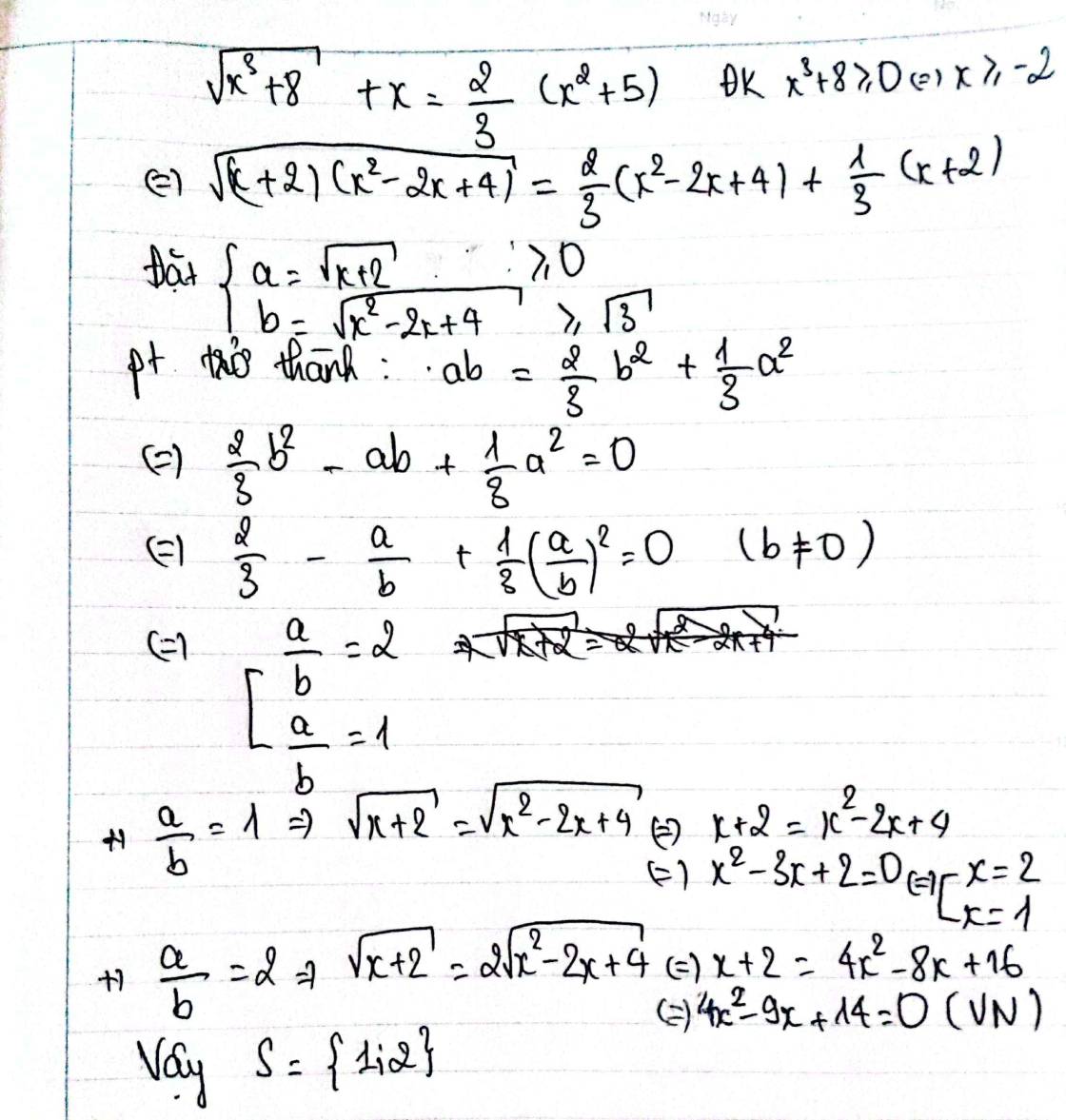
Hãy nhập câu hỏi của bạn vào đây, nếu là tài khoản VIP, bạn sẽ được ưu tiên trả lời.


Thấy x = 0 không phải là n0 của pt
=> pt <=> \(\dfrac{4}{x-8+\dfrac{7}{x}}\) +\(\dfrac{5}{x-10+\dfrac{7}{x}}\) = -1
Đặt x - 9 + \(\dfrac{7}{x}\) = a
=> pt <=> \(\dfrac{4}{a+1}\) + \(\dfrac{5}{a-1}\) = -1
<=> \(\dfrac{9a+1}{\left(a-1\right)\left(a+1\right)}\) = -1
<=> \(\dfrac{9a+1}{a^2-1}\) = -1
<=> 9a + 1 = 1 - a2
<=> a2 + 9a = 0
<=> a(a + 9) = 0
TH1 a = 0 => x - 9 + \(\dfrac{7}{x}\) = 0
<=> x2 - 9x + 7 = 0
<=> ( x - \(\dfrac{9}{2}\) )2 = \(\dfrac{53}{4}\)
<=> x = \(\dfrac{9\pm\sqrt{53}}{2}\)
TH2 a = -9 => x - 9 + \(\dfrac{7}{x}\) = -9
<=> x2 - 9x + 7 = -9x
<=> x2 + 7 = 0 (vô lý)
Vậy x = \(\dfrac{9\pm\sqrt{53}}{2}\)

\(\dfrac{1}{2}x^2-\left(-2+1\right)x+\dfrac{-2-1}{2}=0\)
\(\Rightarrow\dfrac{1}{2}x^2+x-\dfrac{3}{2}=0\)
Tới đây dùng \(\Delta\) chứ, nếu bn lấy \(\dfrac{1}{2}\) đặt lm nhân tử chung thì ở đây hơi vô lí

15
\(\dfrac{7}{x-2}\)+\(\dfrac{8}{x-5}\)=3 (x khác 2 khác 5)
\(\Leftrightarrow\)7*(x-5)+8(x-2)=3(x-2)(x-5)
\(\Leftrightarrow\)15x-51=3x^2-21x+30\(\Leftrightarrow\)3x^2-36x+81=0
\(\Leftrightarrow\)\(\begin{matrix}&\end{matrix}\)\(\left[{}\begin{matrix}9\\3\end{matrix}\right.\) tmđk
16\(\dfrac{x^2-3x+6}{x^2-9}\)=\(\dfrac{1}{x-3}\)(x khác +_3)
\(\Leftrightarrow\)x^2-3x+6=x+3
\(\Leftrightarrow\)x^2-4x+3=0\(\Leftrightarrow\)\(\left[{}\begin{matrix}3loại\\1\end{matrix}\right.\)
vậy x=1 là nghiệm của pt
17 \(\dfrac{3}{x^2-4}\) = \(\dfrac{1}{x-2}+\dfrac{1}{x+2}\)
<=> x + 2 + x - 2 = 3
<=> 2x = 3
<=> x = \(\dfrac{3}{2}\)

\(\left\{{}\begin{matrix}\dfrac{1}{x}+\dfrac{1}{y}=\dfrac{5}{6}\\\dfrac{\dfrac{2}{3}}{x}+\dfrac{\dfrac{2}{3}}{y}+\dfrac{\dfrac{8}{9}}{y}=1\end{matrix}\right.\)\(\Leftrightarrow\left\{{}\begin{matrix}\dfrac{1}{x}+\dfrac{1}{y}=\dfrac{5}{6}\\\dfrac{\dfrac{2}{3}}{x}+\dfrac{\dfrac{14}{9}}{y}=1\end{matrix}\right.\)\(\Leftrightarrow\left\{{}\begin{matrix}\dfrac{1}{x}+\dfrac{1}{y}=\dfrac{5}{6}\left(1\right)\\\dfrac{2}{3x}+\dfrac{14}{9y}=1\left(2\right)\end{matrix}\right.\)
Nhân cả hai vế (1) cho \(\dfrac{2}{3}\) ta có: \(\left\{{}\begin{matrix}\dfrac{2}{3x}+\dfrac{2}{3y}=\dfrac{5.2}{6.3}\\\dfrac{2}{3x}+\dfrac{14}{9y}=1\end{matrix}\right.\)\(\Leftrightarrow\left\{{}\begin{matrix}\dfrac{2}{3x}+\dfrac{2}{3y}=\dfrac{10}{18}\left(3\right)\\\dfrac{2}{3x}+\dfrac{14}{9y}=1\left(4\right)\end{matrix}\right.\)
Lấy (4) trừ (3) ta có:
\(\dfrac{14}{9y}-\dfrac{2}{3y}=1-\dfrac{10}{18}\)\(\Leftrightarrow\dfrac{8}{9y}=\dfrac{4}{9}\)\(\Leftrightarrow y=2\Rightarrow x=\dfrac{1}{\dfrac{5}{6}-\dfrac{1}{2}}=3\)

a: \(\Leftrightarrow x^2+x-6+2x-6=10x-20+50\)
\(\Leftrightarrow x^2+3x-12-10x-30=0\)
\(\Leftrightarrow x^2-7x-42=0\)
\(\text{Δ}=\left(-7\right)^2-4\cdot1\cdot\left(-42\right)=217>0\)
Do đó: Phương trình có hai nghiệm phân biệt là:
\(\left\{{}\begin{matrix}x_1=\dfrac{7-\sqrt{217}}{2}\\x_2=\dfrac{7+\sqrt{217}}{2}\end{matrix}\right.\)
b: \(\Leftrightarrow x^2-3x+5=-x^2+4\)
\(\Leftrightarrow2x^2-3x+1=0\)
\(\Leftrightarrow\left(2x-1\right)\left(x-1\right)=0\)
hay \(x\in\left\{\dfrac{1}{2};1\right\}\)


a.
ĐKXĐ: \(x\ge1\)
\(\sqrt{x-1}+\sqrt{x^3+x^2+x+1}=1+\sqrt{\left(x-1\right)\left(x^3+x^2+x+1\right)}\)
\(\Leftrightarrow\sqrt{x-1}\left(\sqrt{x^3+x^2+x+1}-1\right)-\left(\sqrt{x^3+x^2+x+1}-1\right)=0\)
\(\Leftrightarrow\left(\sqrt{x-1}-1\right)\left(\sqrt{x^3+x^2+x+1}-1\right)=0\)
\(\Leftrightarrow\left[{}\begin{matrix}\sqrt{x-1}=1\\\sqrt{x^3+x^2+x+1}=1\end{matrix}\right.\)
\(\Leftrightarrow\left[{}\begin{matrix}x=2\\x^3+x^2+x=0\end{matrix}\right.\)
\(\Leftrightarrow...\)
b.
ĐKXĐ: \(x\ge-1\)
\(x^2-6x+9+x+1-4\sqrt{x+1}+4=0\)
\(\Leftrightarrow\left(x-3\right)^2+\left(\sqrt{x+1}-2\right)^2=0\)
\(\Leftrightarrow\left\{{}\begin{matrix}x-3=0\\\sqrt{x+1}-2=0\end{matrix}\right.\)
\(\Leftrightarrow x=3\)
c.
ĐKXĐ: \(-2\le x\le\dfrac{4}{5}\)
\(VT=2x+3\sqrt{4-5x}+1.\sqrt{x+2}\)
\(VT\le2x+\dfrac{1}{2}\left(9+4-5x\right)+\dfrac{1}{2}\left(1+x+2\right)=8\)
Dấu "=" xảy ra khi và chỉ khi \(x=-1\)



\(\dfrac{x^2+14x}{x^3+8}=\dfrac{x}{x+2}\)
<=> \(\dfrac{x^2+14x}{\left(x+2\right)\left(x^2-2x+4\right)}=\dfrac{x}{x+2}\)
ĐKXĐ : x+2 \(\ne\)0 => x \(\ne\) -2
<=> x2 + 14x - x (x2 - 2x +4 ) = 0
<=> x ( x+14 -x2+2x -4 ) = 0
<=> x ( -x2 + 3x + 12 ) = 0
\(\left\{{}\begin{matrix}x=0\left(TM\right)\\-x^2+3x+12=0\end{matrix}\right.\)
xét pt -x2 + 3x + 12 = 0
<=> x2 - 3x - 12 = 0
\(\Delta\) = (-3)2 - 4.(-12) = 57 > 0
=> PT có 2 nghiệm phân biệt
x1 = \(\dfrac{3-\sqrt{57}}{2}\) ( TM )
x2 = \(\dfrac{3+\sqrt{57}}{2}\) (TM)
vậy nghiệm của pt là S= \(\left\{0;\dfrac{3-\sqrt{57}}{2};\dfrac{3+\sqrt{57}}{2}\right\}\)
giúp với mọi người ơi
1 người đi xe máy dự dịnh đi từ A đến B với vận tốc 36km/h.nhưng khi thực hiện người ấy giảm vận toc616km/h nên đã đến B chậm hơn dự định là 24 phút. Tính quãng đường AB